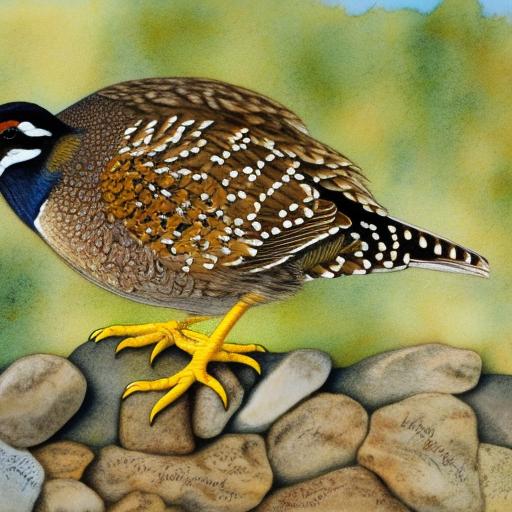The California Valley Quail, also known as the California Quail, is a popular game bird and a favorite among bird enthusiasts. These small, plump birds are native to the western United States and are known for their distinctive teardrop-shaped plume on their heads. They are highly adaptable and can be found in a variety of habitats, from coastal scrub to mountain forests. California Valley Quail are known for their sociable nature and can often be seen in large coveys, foraging for seeds and insects on the ground.
These birds are prized for their delicious meat and are often hunted for sport. In recent years, there has been a growing interest in raising California Valley Quail for their eggs and meat, as well as for their striking appearance. With the right knowledge and resources, breeding California Valley Quail can be a rewarding and profitable venture. In this article, we will explore the process of selecting breeding stock, creating the ideal breeding environment, the breeding and incubation process, caring for chicks, health and disease management, and selling and marketing quail chicks.
Key Takeaways
- California Valley Quail are popular game birds known for their hardiness and adaptability
- When selecting breeding stock, look for healthy, active birds with good coloration and markings
- Create the ideal breeding environment by providing ample space, proper nutrition, and suitable nesting areas
- The breeding and incubation process involves collecting and storing eggs, incubating them, and caring for the chicks once they hatch
- Caring for quail chicks involves providing warmth, proper nutrition, and protection from predators
Selecting Breeding Stock
When it comes to breeding California Valley Quail, selecting the right breeding stock is crucial to the success of your breeding program. It is important to choose birds that are healthy, strong, and have desirable traits such as good size, coloration, and temperament. Look for birds that are active, alert, and have a good body conformation. Avoid birds that show signs of illness or deformities.
It is also important to consider the genetic diversity of your breeding stock. Inbreeding can lead to a host of health and reproductive issues in quail, so it is important to introduce new bloodlines into your flock regularly. When selecting breeding stock, look for birds that come from different sources to ensure genetic diversity. Additionally, consider the age of the birds you are selecting. Younger birds are generally more fertile and have a longer breeding lifespan than older birds. By carefully selecting your breeding stock, you can ensure that your quail will produce healthy offspring with desirable traits.
Creating the Ideal Breeding Environment
Creating the ideal breeding environment is essential for the health and productivity of your California Valley Quail. The first step is to provide a spacious and well-ventilated housing for your quail. A well-ventilated coop will help prevent respiratory issues and keep the birds comfortable. The coop should also be predator-proof to protect your quail from potential threats such as raccoons, foxes, and birds of prey.
In addition to a secure coop, it is important to provide your quail with a suitable nesting area. Quail prefer to nest on the ground, so providing them with a shallow tray filled with sand or soil will encourage natural nesting behavior. It is also important to provide plenty of hiding spots and cover in the form of shrubs or artificial shelters to give the quail a sense of security.
Finally, it is important to provide your quail with a balanced diet to support their reproductive health. A high-quality game bird feed supplemented with fresh greens, seeds, and insects will provide the necessary nutrients for healthy egg production and chick rearing. By creating a suitable breeding environment for your quail, you can ensure that they are comfortable, healthy, and productive.
Breeding and Incubation Process
Breeding California Valley Quail is a relatively straightforward process, but there are a few key considerations to keep in mind. Quail are prolific breeders and will begin laying eggs at around 8-10 weeks of age. To encourage successful breeding, it is important to maintain a proper male-to-female ratio in your flock. A ratio of one male to every three to five females is ideal to prevent overbreeding and aggression among the males.
Once your quail begin laying eggs, it is important to collect them daily to prevent them from being damaged or eaten by the birds. The eggs should be stored in a cool, dry place with the pointed end facing downward until they are ready for incubation. When it comes to incubating quail eggs, a specialized quail egg incubator is recommended to ensure optimal hatch rates. The eggs should be kept at a consistent temperature of around 100 degrees Fahrenheit with a humidity level of 50-60% for 16-18 days until they hatch.
During the incubation process, it is important to regularly monitor the temperature and humidity levels to ensure that the eggs develop properly. Turning the eggs several times a day will also help prevent the embryos from sticking to the shell membrane. After 16-18 days of incubation, the eggs will begin to hatch, and within 24 hours, you will have a new batch of adorable quail chicks.
Caring for Chicks
Caring for quail chicks requires attention to detail and proper husbandry practices to ensure their health and well-being. Once the chicks have hatched, it is important to move them to a brooder with a heat source such as a heat lamp or heating pad to keep them warm. The brooder should be kept at a temperature of around 95 degrees Fahrenheit for the first week and then gradually decreased by 5 degrees each week until they are fully feathered.
In addition to providing warmth, it is important to provide the chicks with a high-quality game bird starter feed that is high in protein to support their rapid growth and development. Fresh water should also be provided at all times, preferably in shallow dishes to prevent drowning.
As the chicks grow, it is important to monitor their health closely for any signs of illness or distress. Regularly cleaning the brooder and providing fresh bedding will help prevent disease and keep the chicks comfortable. By providing proper care and nutrition, you can ensure that your quail chicks grow into healthy and robust adults.
Health and Disease Management

Maintaining the health of your California Valley Quail is essential for the success of your breeding program. Regular health checks and preventative measures can help keep your quail free from disease and illness. It is important to monitor your quail for any signs of illness such as lethargy, loss of appetite, or abnormal droppings. If you notice any signs of illness, it is important to isolate the affected bird and seek veterinary care if necessary.
In addition to regular health checks, it is important to practice good biosecurity measures to prevent the spread of disease within your flock. This includes regularly cleaning and disinfecting the coop and equipment, as well as preventing contact with wild birds or other potential sources of disease.
It is also important to provide your quail with a balanced diet and access to clean water at all times to support their immune system and overall health. By practicing good husbandry practices and monitoring your quail closely, you can help prevent disease and ensure the long-term health of your flock.
Selling and Marketing Quail Chicks
Once you have successfully bred and raised a new generation of California Valley Quail, you may be interested in selling them for profit or as pets. There is a growing market for quail chicks as pets, for hunting preserves, or for backyard hobbyists interested in raising their own quail.
When it comes to selling quail chicks, it is important to consider your target market and tailor your marketing efforts accordingly. If you are selling quail chicks as pets or for backyard hobbyists, consider advertising on social media platforms or local classifieds. Highlight the benefits of raising quail as pets or for their eggs and meat.
If you are targeting hunting preserves or game bird enthusiasts, consider attending trade shows or reaching out to local hunting clubs or organizations. Networking with potential buyers can help you establish a customer base for your quail chicks.
It is also important to ensure that you comply with any local regulations or permits required for selling quail chicks in your area. By marketing your quail chicks effectively and building relationships with potential buyers, you can successfully sell your quail chicks and potentially expand your breeding program in the future.
In conclusion, breeding California Valley Quail can be a rewarding and profitable venture with the right knowledge and resources. By carefully selecting breeding stock, creating an ideal breeding environment, managing the breeding and incubation process, caring for chicks, maintaining their health, and effectively marketing them, you can successfully breed California Valley Quail and contribute to their conservation while enjoying the benefits of this fascinating bird species.
If you’re interested in California valley quail breeding, you may also want to explore an article on the importance of the right chicken coop door size for your poultry. Understanding the optimal coop door size can contribute to creating a comfortable and safe environment for your quails, as well as other poultry. Check out the article on Poultry Wizard for valuable insights into this aspect of poultry care.
FAQs
What is California Valley Quail breeding?
California Valley Quail breeding refers to the process of raising and breeding California Valley Quail, a popular game bird known for its distinctive plume on its head.
What are the key considerations for California Valley Quail breeding?
Key considerations for California Valley Quail breeding include providing proper housing, nutrition, and care for the birds, as well as ensuring a suitable breeding environment.
What is the breeding season for California Valley Quail?
The breeding season for California Valley Quail typically occurs in the spring and early summer, with peak breeding activity taking place during these months.
What are the ideal conditions for breeding California Valley Quail?
Ideal conditions for breeding California Valley Quail include providing a spacious and secure breeding enclosure, a balanced diet rich in protein, and a stress-free environment.
How long does it take for California Valley Quail eggs to hatch?
California Valley Quail eggs typically take about 21 days to hatch once they have been laid.
What are some common challenges in California Valley Quail breeding?
Common challenges in California Valley Quail breeding include maintaining proper temperature and humidity levels for egg incubation, preventing disease outbreaks, and ensuring the health and well-being of the birds.
Meet Walter, the feathered-friend fanatic of Florida! Nestled in the sunshine state, Walter struts through life with his feathered companions, clucking his way to happiness. With a coop that’s fancier than a five-star hotel, he’s the Don Juan of the chicken world. When he’s not teaching his hens to do the cha-cha, you’ll find him in a heated debate with his prized rooster, Sir Clucks-a-Lot. Walter’s poultry passion is no yolk; he’s the sunny-side-up guy you never knew you needed in your flock of friends!







